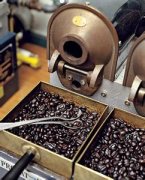Coffee futures American type C futures Arabica coffee bean price trend quotation contract latest news
Professional coffee knowledge exchange more coffee bean information please follow the coffee workshop (Wechat official account cafe_style)
For more boutique coffee beans, please add private Qianjie coffee on Wechat. WeChat account: qjcoffeex
Recently, there are two kinds of coffee bean futures contracts that have been traded in the coffee, sugar and cocoa business in New York: type C coffee beans (Arabica coffee beans from 19 countries since delivery, but not Brazil), and Brazilian type B coffee beans. However, the B-type coffee bean futures contract was announced off the market in 1982 because the business was not booming. At present, only the C-type coffee bean futures contract does business in this business. In the London Commodity Trading Office (LCE), there is Robusta's U-shaped coffee bean futures contract. The primary reason for different types of coffee bean futures contracts is distance: new York is closer to Naaman, while London is next to Africa. As a matter of fact, between 1968 and 1970, the New York Coffee, Sugar and Cocoa Trading Institute also launched Robusta's U-shaped coffee bean futures contract, but the business was slow and went off the market.
In the type C coffee bean futures contract traded in the coffee, sugar and cocoa business in New York, the price will be increased or subtracted according to the scale price because of differences from the country at the time of delivery. Colombian coffee beans are the only coffee beans that can be increased (2 cents per pound). Lucky first-class coffee beans in other countries are only the same as the standard price, and some can be reduced to 6 cents per pound (Ethiopia).
Price choice identity
The primary factors that affect the price of coffee beans can be summarized into five categories: changes in supply, weather changes and insect pests, government policies and international coffee organization, strikes and market rumors, and seasonal status.
1. A change in supply
two。 Government policies and International Coffee Organization methods
The price of coffee beans is of course related to its supply and demand, but the demand for coffee beans is quite unchanged, and the change in supply has become a choice of short-term price changes, especially the output of major producing countries such as Brazil and Colombia is the focus of the market. It is worth noting that the coffee beans produced in Brazil are not the subject matter of CSCE delivery, but because Brazil produces the most, the change in Brazilian production will naturally affect the change in the price of all coffee beans.
3. Causes of weather changes and insect pests
Brazil's coffee bean production is not only the largest in scale, but its development is also subject to weather conditions (drought and frost), making its position in the coffee bean market more seriously. Every year, June and July is the frost season in Brazil, during this period, whether there is frost damage in Brazil has become the primary factor affecting the price of coffee beans. Because most other Latin American countries are stable in terms of temperature and rainfall, the weather change in Brazil is the focus of coffee bean businessmen.
Generally speaking, the weather condition in the Western Hemisphere is the most important factor affecting the price of coffee beans, and insect pests are the most important problem of coffee production in the Eastern Hemisphere, but in recent years, due to the improvement of deworming skills and the reduction of costs, insect pests are no longer one of the main factors affecting the price trend of coffee beans.
In the atmosphere of ghosts in various member States, after many consultations, it is still not possible to draw up new international coffee peace talks, so unless the International Coffee Organization can draw up a convention agreed by member States, otherwise, the influence of the International Coffee Organization on the price of coffee beans will gradually weaken.
The government policy of the primary coffee producing country is also the focus of the coffee bean market. From this point of view, the government policy of ─ Brazil, the world's largest coffee bean producer, is more important than that of other countries. When the Brazilian government decides to store most of its coffee beans, it does raise coffee prices in the short term, but it also allows Colombia or other Central American and African producers to increase their market share.
4. Strikes and market rumors
There are strikes or rumors among dock workers at the primary coffee export port, which sometimes affect the price of coffee beans, because this can lead to an increase in inventory or market expectations. Because the primary coffee producing countries are in developing countries, strikes can be said to be heard from time to time, but sometimes it is difficult to spread the false, but unless it is a protracted strike, the time to affect market prices will not be too long.
5. Seasonal identity
Because Brazil is the world's largest producer of coffee beans, there is a high chance that prices will be low during the harvest period from April to August, especially from June to July, and then they will gradually stabilize, reaching a high between January and February the following year. This is because winter in the northern hemisphere is the most depleted season for coffee beans.
However, past data have shown that the probability of frost damage or drought during the Brazilian coffee harvest is also high, such as disasters often lead to a rapid rise in prices. Even if the probability of frost damage expected in Brazil or other Central Naaman producing countries is not high during this period, the risk of buying coffee bean futures is still lower than shorting, because sometimes there are false rumors about frost damage or disaster in the market, which often greatly increases the price of coffee beans before confirmation.
Coffee beans are the largest material in global business volume, second only to crude oil. The rise and fall of prices are closely related to the politics and economy of the producing countries of coffee beans. For decades, coffee beans have been the most congenial commodity in the world. Market traders, brokers, futures businessmen and coffee bean producing countries have all joined hands to buy short, sell short and make a profit. Since July 1999, Brazil, the largest producer, has experienced severe drought, affecting the flowering of coffee trees. The market expects a sharp decline in Brazil's future production capacity, which may lead to excessive demand. Coffee bean futures echo a big rise, reaching a high price of US $1.50 per pound in October last year. However, the good times are not long. In December 1999, Brazil had a heavy rain, the disaster was relieved, and the price of beans plummeted. It has come true that coffee beans are the most popular commodity in the world.
According to the actuary of the country where coffee beans are produced, coffee farmers can only make a profit if the price of coffee beans is more than one dollar per pound. Over the past half a century, whenever beans see through the one-dollar barrier, coffee producing countries will offer plans to "seal beans into storage". In other words, the government will raise a sum of money to buy surplus coffee beans on the market and store them in large warehouses to reduce smooth coffee beans, thus driving up the price of coffee beans, which is very useful. However, it coincides with the bad weather in the producing country of coffee beans in the past two years, and the intention of "sealing beans into storage" is not as good as expected, and the price of coffee beans continues to linger in the low range.
The fact of the power of a country? The outcome was limited, so the producing countries formed the International Coffee Organization (ICO) to draw up the total amount of coffee exports and the export quotas of each producing country, so as to maintain the price of coffee beans with dry and market supply. However, since the middle of 1980, the supply of coffee beans has increased, which has led to a gap in the originally smooth operation of the system. On the one hand, the cost of obtaining coffee beans remains high as a result of consumers' unwillingness to reward their identities. On the other hand, coffee-producing countries also began not to abide by export quotas and negotiations because of bumper harvests year after year, one after another to increase the number of exports. On the contrary, the peace talks have become an amulet of Figuo's market share.
Note: international Coffee Organization
The International Coffee Organization is an intergovernmental organization founded in London in 1963. It is composed of coffee importers and exporters. The organization is responsible for implementing the International Coffee Convention to maintain a reasonable price of coffee and improve the wealth of coffee in the world.
Important Notice :
前街咖啡 FrontStreet Coffee has moved to new addredd:
FrontStreet Coffee Address: 315,Donghua East Road,GuangZhou
Tel:020 38364473
- Prev

Coffee popular Science-White Coffee
White coffee is a native product of Malaysia with a history of more than 100 years.
- Next

Unveil the mystery of coffee roasting
You may find it hard to imagine that there are 700 to 850 aromatic substances in a small coffee bean locked in the raw bean in the form of a password. But raw coffee beans can't be detected without roasting these fragrant pits, it's just a code. It can be seen that coffee roasting is of great significance to coffee.
Related
- Beginners will see the "Coffee pull flower" guide!
- What is the difference between ice blog purified milk and ordinary milk coffee?
- Why is the Philippines the largest producer of crops in Liberia?
- For coffee extraction, should the fine powder be retained?
- How does extracted espresso fill pressed powder? How much strength does it take to press the powder?
- How to make jasmine cold extract coffee? Is the jasmine + latte good?
- Will this little toy really make the coffee taste better? How does Lily Drip affect coffee extraction?
- Will the action of slapping the filter cup also affect coffee extraction?
- What's the difference between powder-to-water ratio and powder-to-liquid ratio?
- What is the Ethiopian local species? What does it have to do with Heirloom native species?

